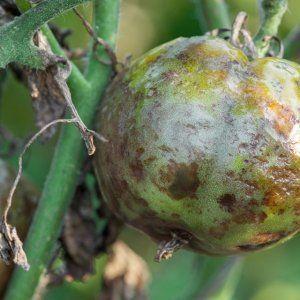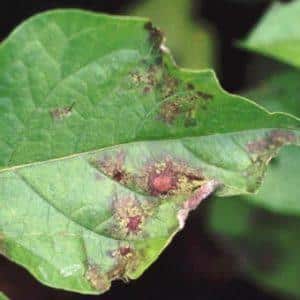How and how to combat late blight on tomatoes in a greenhouse: the best methods and reviews from gardeners
There are cases in history when the late blight fungus caused the famine of an entire state. For example, in the 19th century in Ireland it destroyed the potato crop. Today, late blight most often affects tomatoes and zucchini.
Gardeners use many tools and methods to help prevent late blight or cure the plant when it has already occurred.
What kind of disease is this
Late blight is the most common disease affecting plants. It was first discovered in the countries of Europe and Central Asia. The fungus is dangerous for raspberries, strawberries, coniferous and deciduous trees, potatoes, peppers and many other crops.
How does it affect tomatoes?
The development of fungus leads to the death of bushes. If you do not fight the infection, it will even destroy the fruits, regardless of their degree of ripening. Large brown and brown spots appear on the tomatoes. The last stage is rotting. It is impossible to cure plants. Sometimes the fungus destroys 50-80% of the entire crop.
Symptoms and external signs
Late blight appears as yellow and brown spots on the leaves. Also, in some cases, a white coating forms. In addition, a universal sign is the appearance of transparent mold, similar to a cobweb.
The affected parts of the bush die off in a short time, which entails the death of the entire plant. The tomatoes themselves lose their appearance and taste.

Causes of appearance and infection
Let's look further at what causes the disease and how to prevent it.
The causative agent of the disease
The causative agent is the fungus Phytophthora. The disease is spread by spores. The pathogen enters the plant through the stomata and gradually spreads throughout the bush. Also, spores are washed away by rain and dew into the soil, and then infect nearby beds. The spores affect any part of the bush.
Terms of distribution
Provoke the appearance late blight Tomatoes have high humidity and high air temperatures. That is why in hot and rainy summers it is advised to reduce the amount of watering and pay special attention to tomato bushes.
Most often, late blight appears in the second half of summer, when the weather is hot. Fog or dew, as well as sudden temperature changes, are also excellent conditions for the spread of fungus.
Important! Late blight most quickly attacks weak bushes. The health of tomatoes depends on the quality soil, availability of fertilizers and appropriate care. To increase immunity, feed vegetables with organic matter and minerals, regularly loosen the soil and remove weeds.
Another condition for the spread of fungus is contaminated soil. That is why it is necessary to collect all garden debris and leaves in the fall. Plant remains and last year's soil may contain spores and other dangerous microorganisms. The disease can appear in both the northern and southern regions of the country.
How and with what to treat
What to do if vegetables are affected by late blight? Fortunately, there are a huge number of professional drugs and folk recipes that can cure late blight.
Chemicals
 Popular among chemicals is "Fitosporin-M".It is available in the form of powder, paste or liquid. The action begins from the moment of processing. The product can be used in any weather conditions.
Popular among chemicals is "Fitosporin-M".It is available in the form of powder, paste or liquid. The action begins from the moment of processing. The product can be used in any weather conditions.
The remedy "Fundazol". The therapeutic effect appears within the first three days. The protective function begins in the next 7 days. “Fundazol” is safe, but if applied excessively to the soil it is phytotoxic. It can be used both in late spring and early autumn.
A drug "Planzir"- the most powerful remedy for late blight. It can be used at any stage of plant development. It is low-toxic and effective not only in the fight against late blight, but also against other types of fungal infections. It must be used strictly in accordance with the recommendations on the packaging.
Another effective chemical for combating fungus is the widely known “Quadris". Has a preventive and therapeutic effect. It is recommended to use the drug no more than twice, otherwise the fungus becomes addictive. Safe for all types of crops, effective when alternating with other fungicides.
Important! The drugs listed above are classified as fungicides. This is a special group of drugs aimed at treating fungus. They can be preventive or protective. Fungicides can be used for spraying or as an addition to watering. In addition, they are added to fertilizing. The products are characterized by low toxicity and availability. Sold at any gardening store.
Traditional methods and agrotechnical techniques
The methods are popular because they are absolutely safe for both plants and humans. After treatment with folk remedies, you can eat tomatoes and not worry about your health.
We present the TOP 5 effective folk remedies against late blight:
 Spraying with a whey-based solution. When the liquid gets on the leaves, it forms a protective film, and it becomes difficult for spores to penetrate inside the plant. The method is used mainly in the early stages of infection, since special chemicals are used for a stronger effect. For example, a mixture of whey and Fitosporin M is often used.
Spraying with a whey-based solution. When the liquid gets on the leaves, it forms a protective film, and it becomes difficult for spores to penetrate inside the plant. The method is used mainly in the early stages of infection, since special chemicals are used for a stronger effect. For example, a mixture of whey and Fitosporin M is often used.- Spraying based on hay, grass and urea. To make the product you will need a bucket of water, 1 kg of grass or hay, 20 g of urea. After the mixture has been infused for 3-4 days, it is filtered. Apply every 2 weeks.
- Wood ash based solution. When diluting ash in water, not only an effective remedy for fungus is obtained, but also a drug that affects the overall health of plants. Wood ash is an excellent product for tomatoes; fertilizing based on it is applied at the stage of preparing seedlings.
- A mixture of garlic, potassium permanganate and water. Manganese has a strong disinfectant effect, and garlic protects the leaves from spores. It is recommended to treat bushes with this mixture every 10 days. If there is frequent rain, the interval is reduced.
- Spray based iodine. To do this, dissolve 1 teaspoon of iodine in 10 liters of water. Store the solution in a dry and dark place, and spray every 8-10 days.
Agricultural practices include burning infected parts of the plant. If you see that late blight has “conquered” the entire bush, immediately remove it from the garden bed. Also treat the ground and hard surfaces: greenhouse walls, pegs, doors, and so on.
Preventive measures
Fungal spores persist not only in soil and plants, but also on garden tools.For example, on irrigation devices. Therefore, before planting the crop, be sure to observe the following measures:
 Collection of garbage, weeds, plant debris.
Collection of garbage, weeds, plant debris.- Their elimination is away from the place where vegetables are supposed to be planted.
- Treating the ground and all hard surfaces with disinfectants, for example, a manganese-based solution.
- Disinfection of seeds at the seedling preparation stage. It is recommended to disinfect seed material by soaking it in hydrogen peroxide.
- Choose a bright, warm place to plant tomatoes. Avoid areas near groundwater or bodies of water.
- If tomatoes are planted in a greenhouse, ventilate it regularly.
- Monitor the watering schedule. Do not allow the soil to become waterlogged or dry out.
As a preventative measure, use Trichopolum. This medicine is sold at any pharmacy and is available without a prescription. It is used both for open ground and for greenhouses and greenhouses.
"Trichopol" is used throughout the gardening season. In addition to tomatoes, cucumbers and zucchini. The bushes are initially watered at the beginning of the summer season. Available in the form of tablets, which are crushed in water.
To protect the harvest, they use a drug called “Gamair”, which suppresses pathogens without harming the plants. Available in the form of dry powder or tablets. For 10 liters of water, 2 tablets are required.
For the most powerful effect, add liquid soap to the solution. Spraying is carried out in early spring 2-3 times with an interval of 7 days. Helps restore plant microflora, relieves soil toxicity, and is safe for humans and plants.
Advice from gardeners
 Experienced gardeners recommend wrapping the roots of seedlings with copper wire before planting. Some people simply pierce the tomato stem with it. How it works? Copper normalizes plant respiration and enhances oxidative processes.
Experienced gardeners recommend wrapping the roots of seedlings with copper wire before planting. Some people simply pierce the tomato stem with it. How it works? Copper normalizes plant respiration and enhances oxidative processes.
As a result, the bushes stop growing and become more resistant to fungi. The stems are pierced only after they have become powerful. Never wrap the wire around the stem.
In addition, Bordeaux mixture takes pride of place among protective products. It is a mixture of water, copper sulfate and lime. The solution can be purchased at the store or prepared independently.
The drug is dangerous for humans, so when using it you must follow safety precautions - use protective clothing, goggles, and a respirator. Use Bordeaux solution at least 2 weeks before harvest.
Important! Tomato growers often recommend using a saline solution. You will need a bucket of water and a mug of table salt. The mixture will not only help get rid of the disease, but also protect the bushes.
Conclusion
How to fight fungus? In this matter, all means are good. Pay attention to preventative measures. Even at the seedling stage, take care of the plants - harden them and feed them on time. Provide the plant with all the necessary conditions for normal development. Remember about watering, do not allow excess moisture. This is especially true during hot periods.
If late blight does affect the plant, immediately carry out health procedures. If you don’t have special preparations on hand, use regular garlic solution or potassium permanganate. It is easiest to prevent late blight in the early stages.